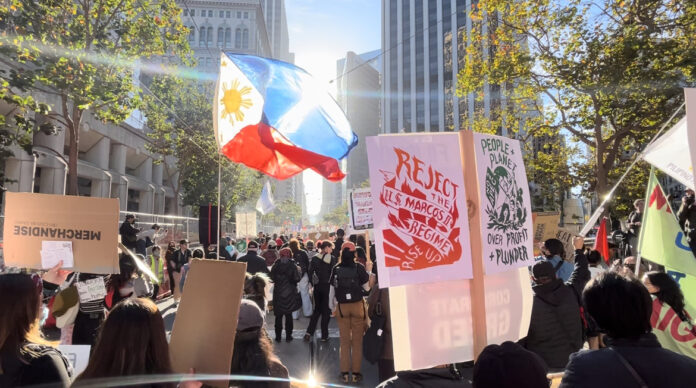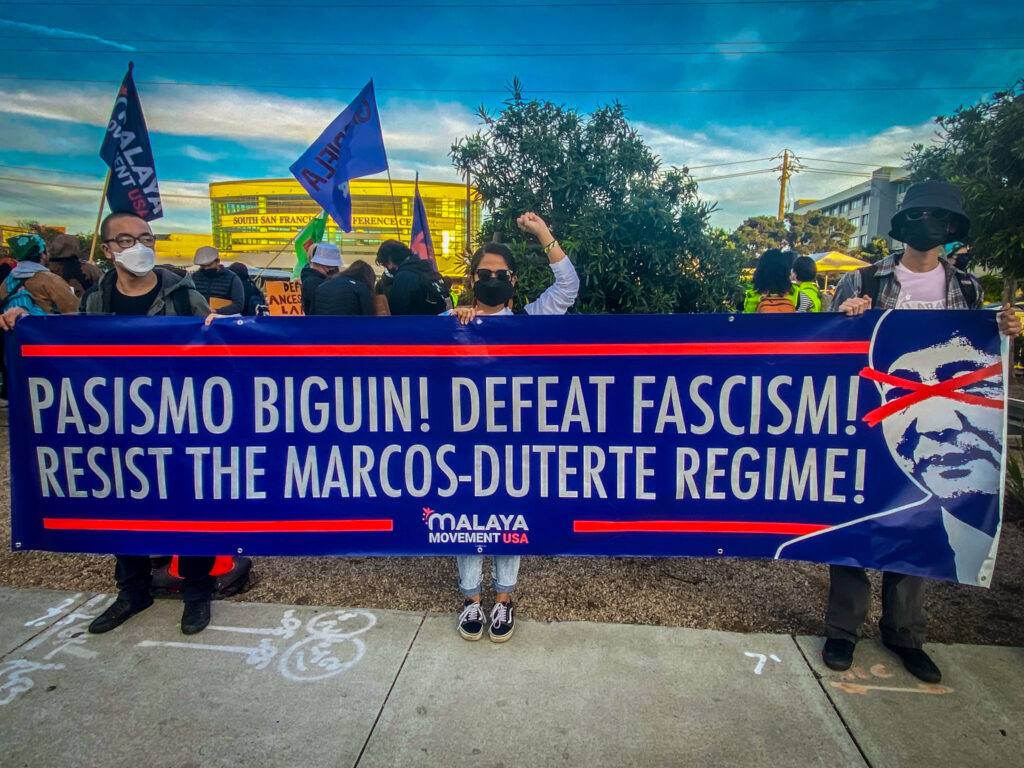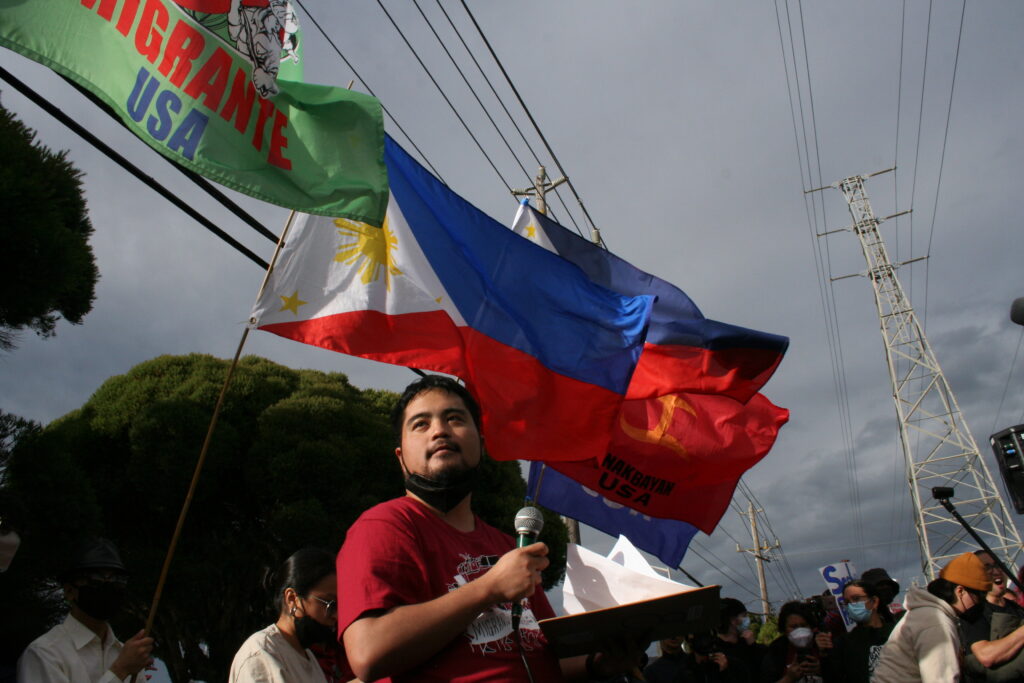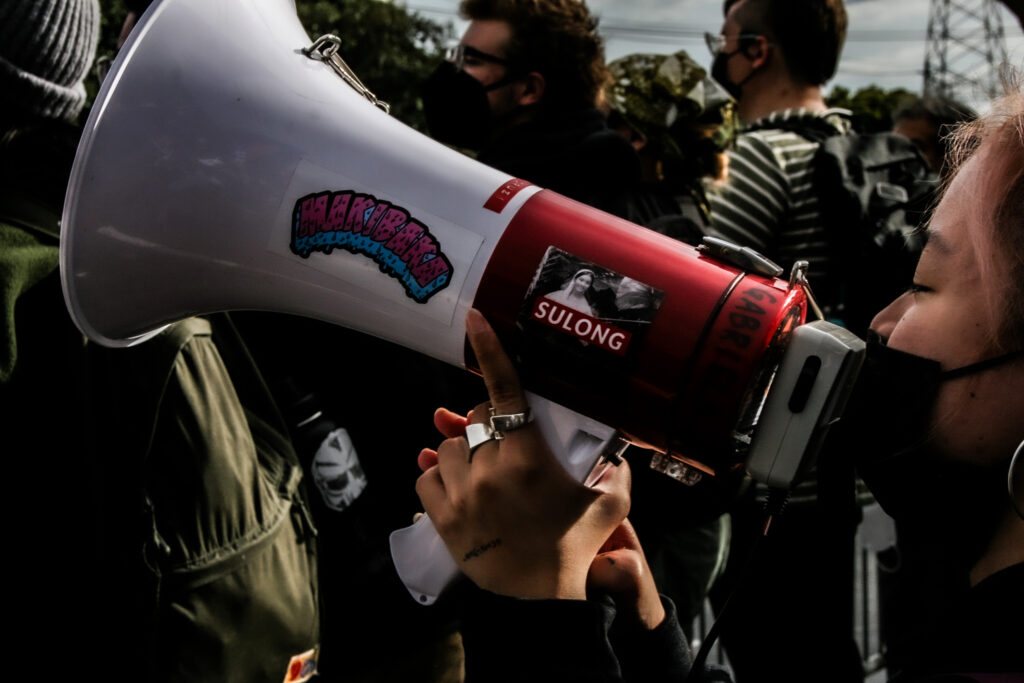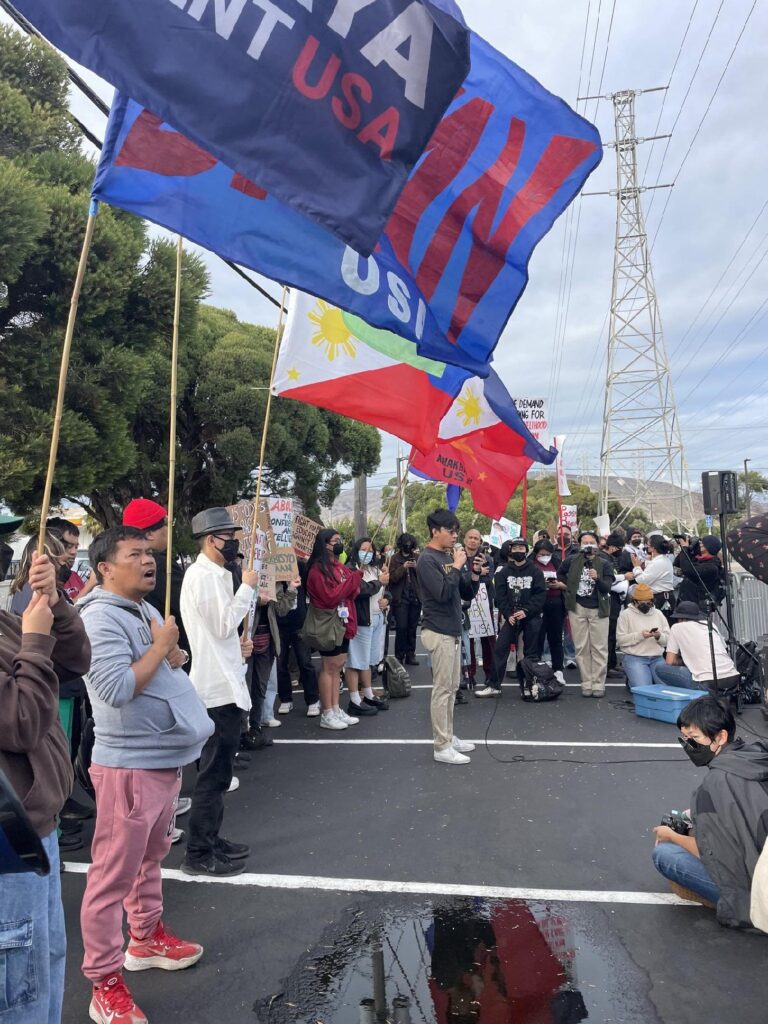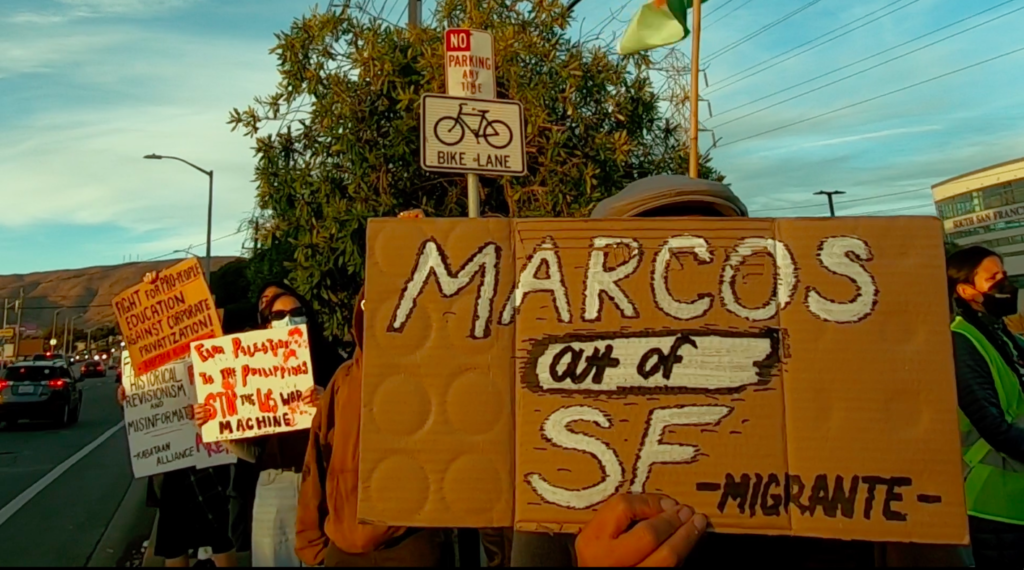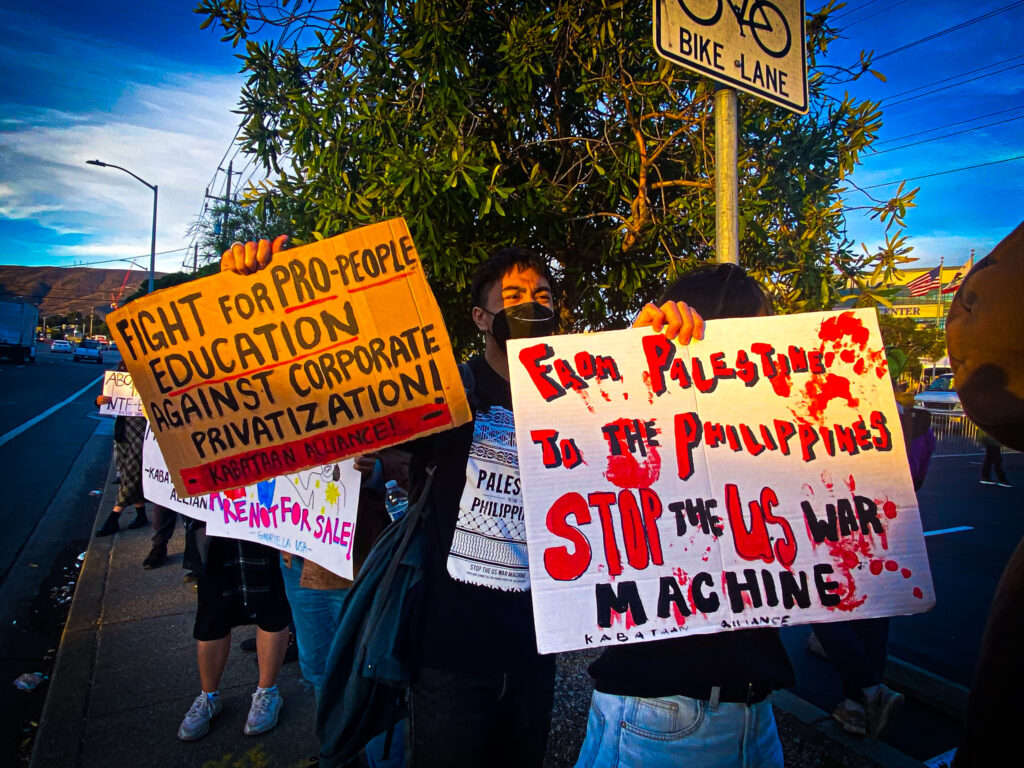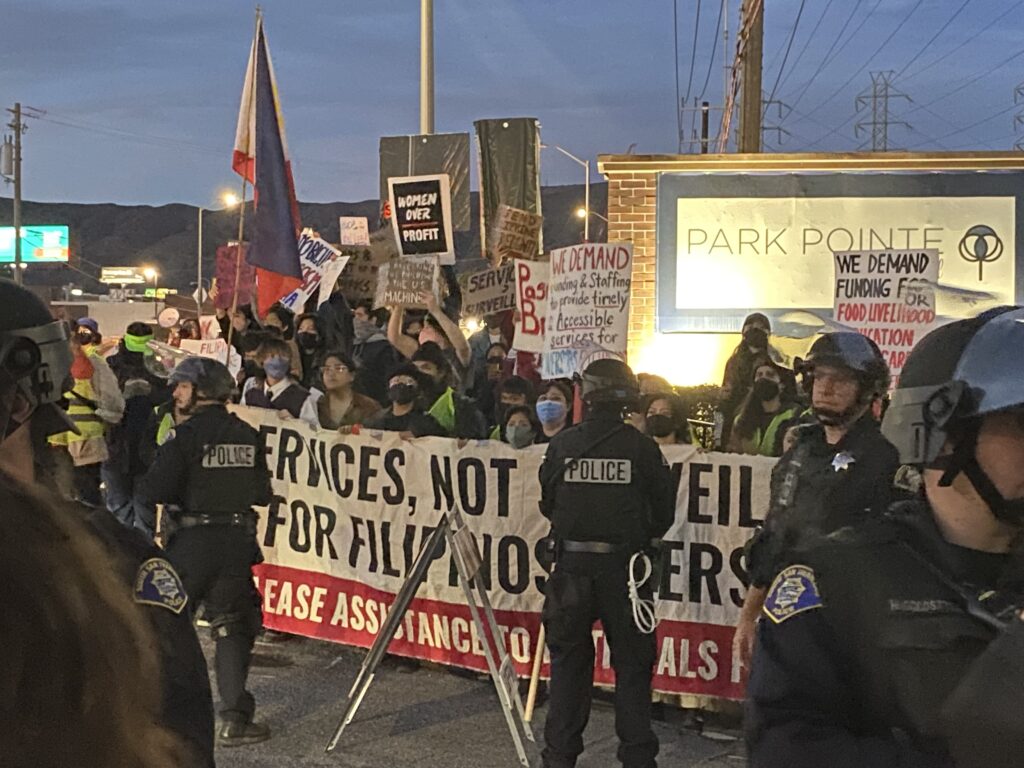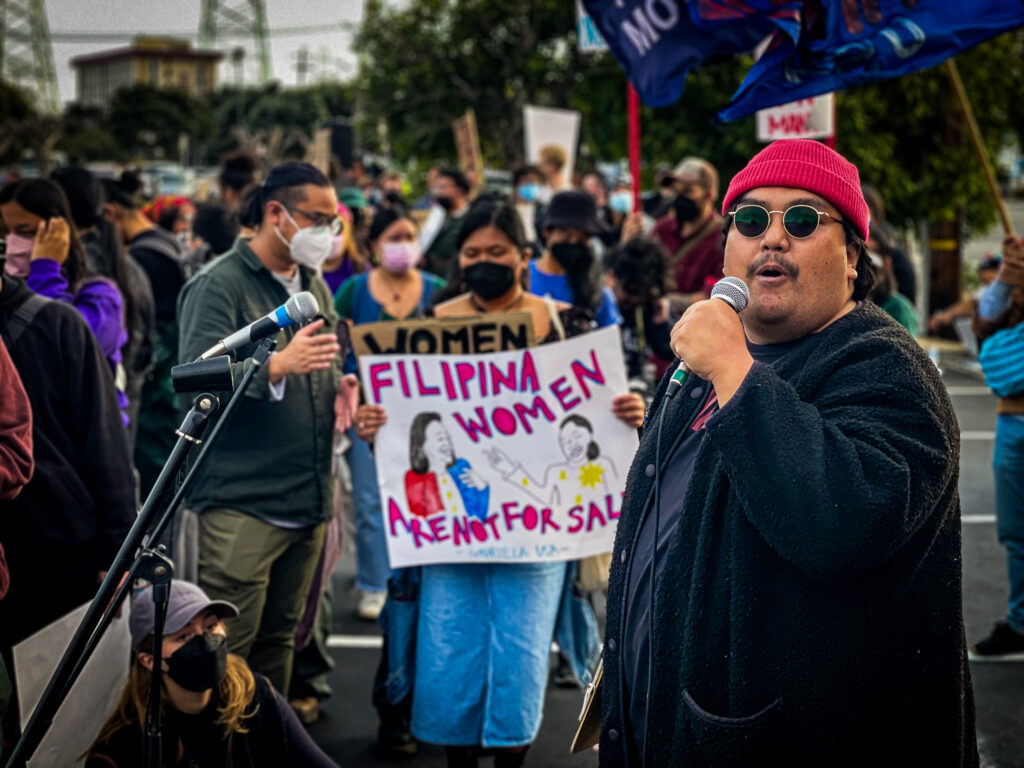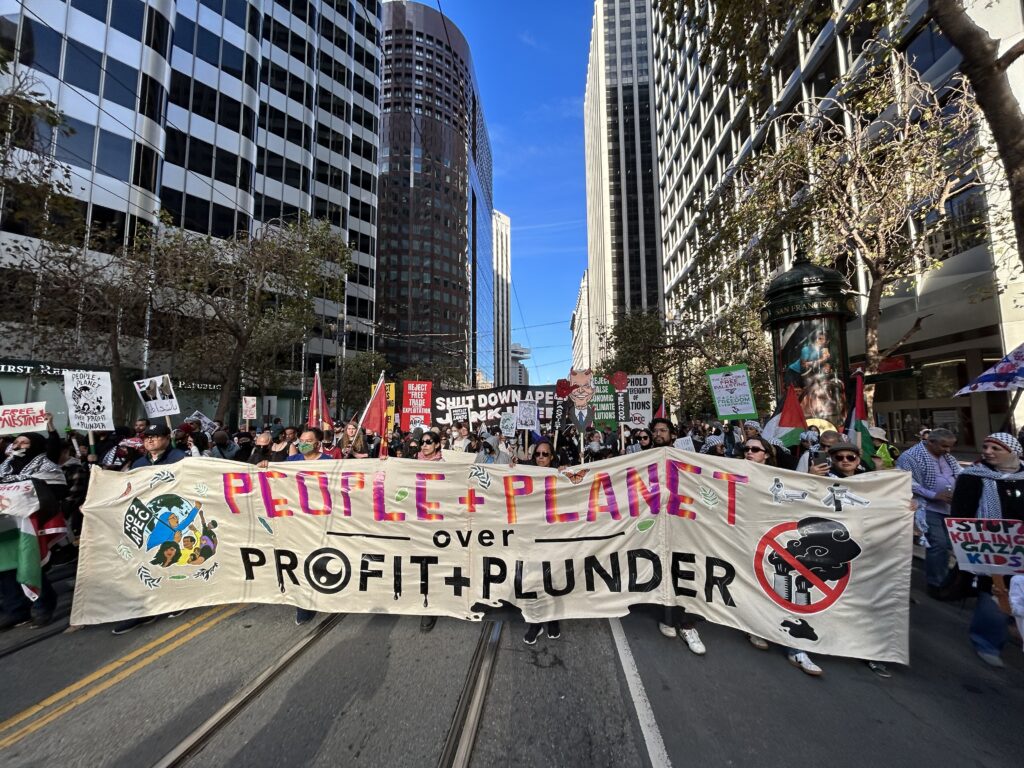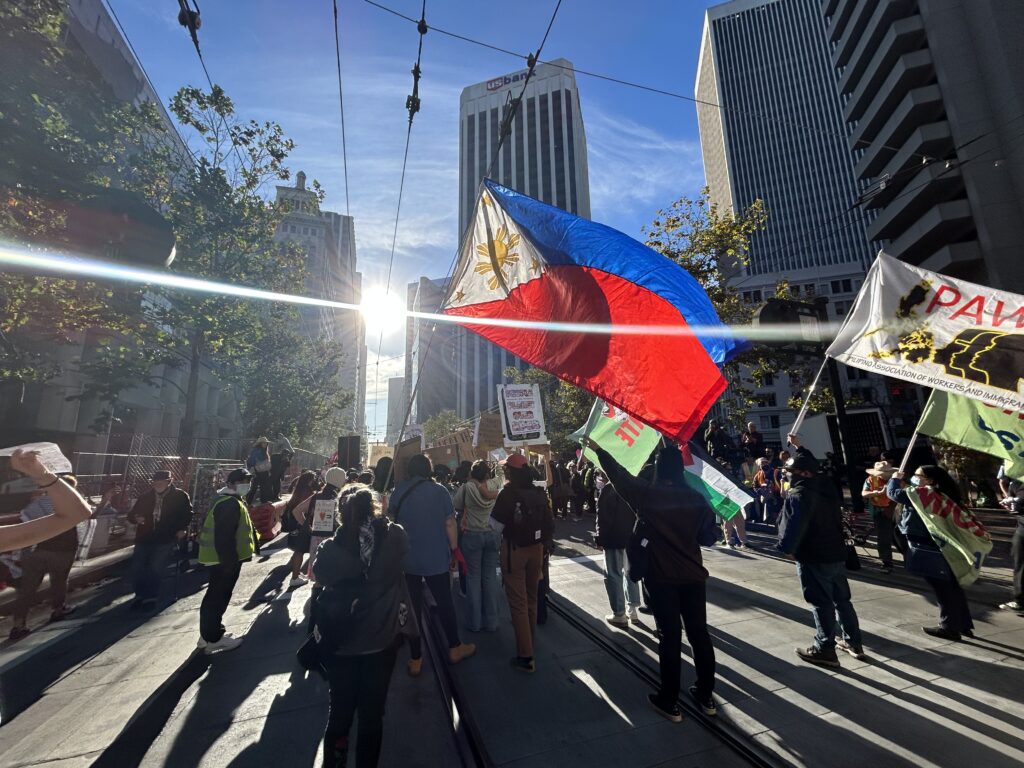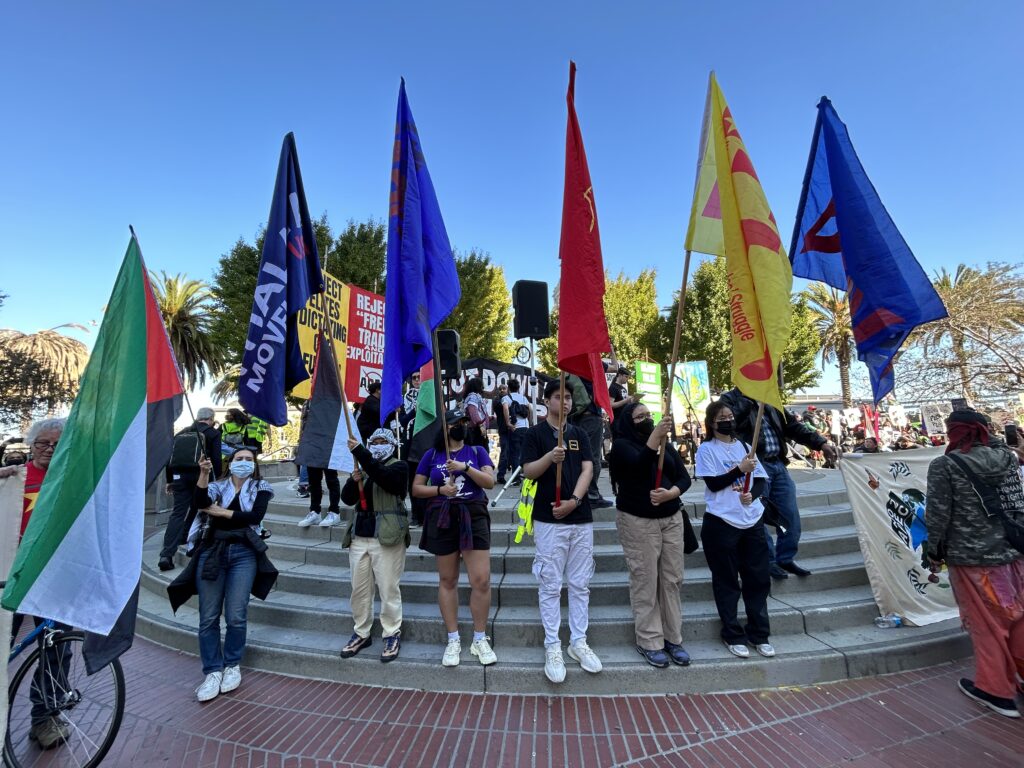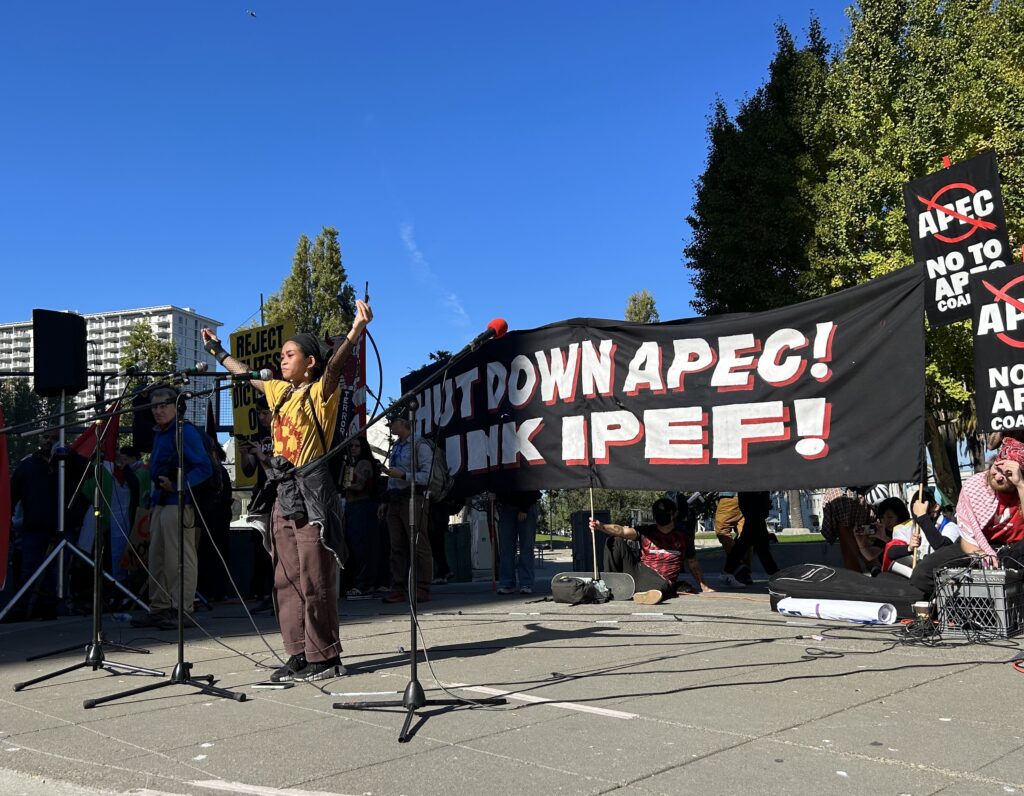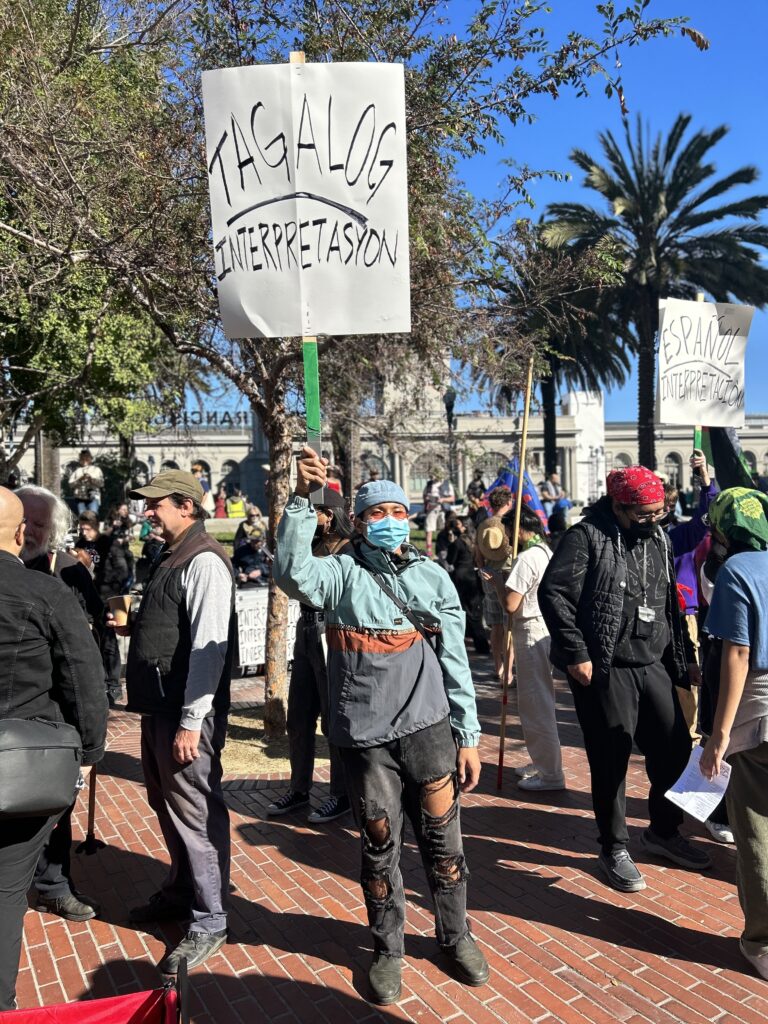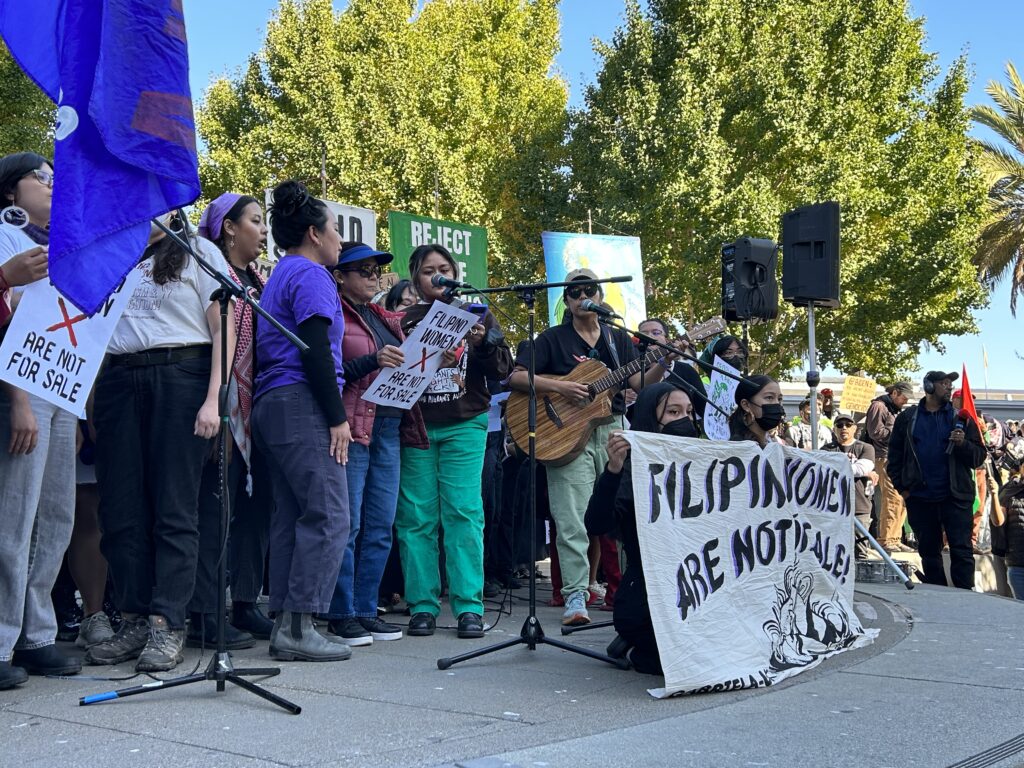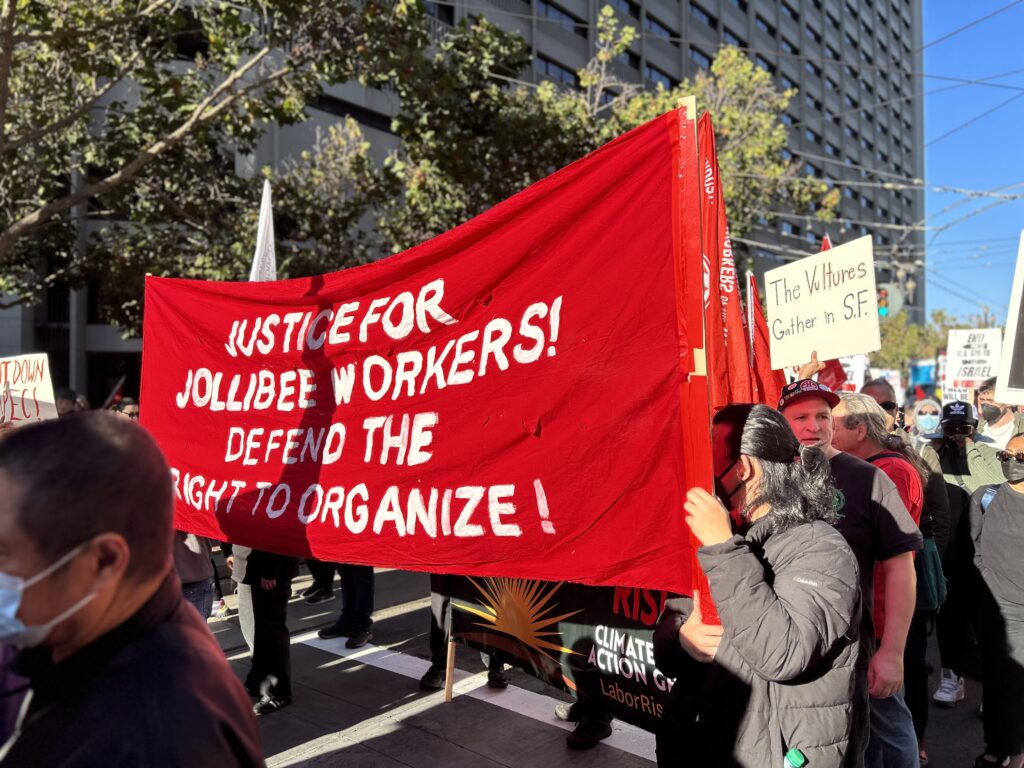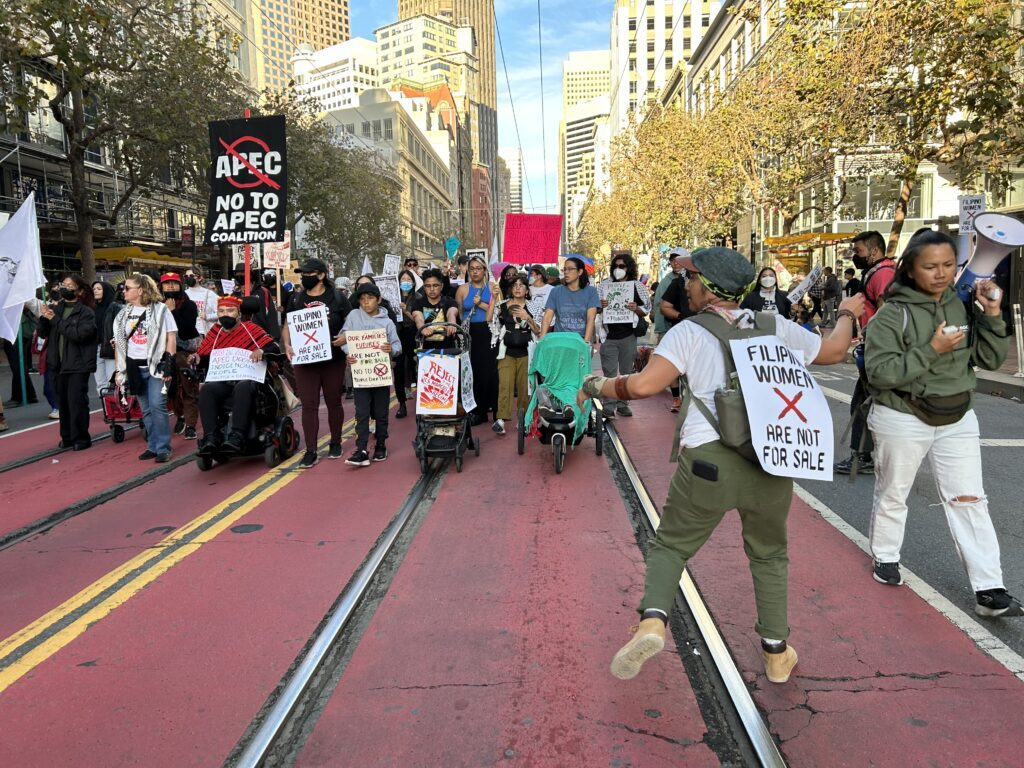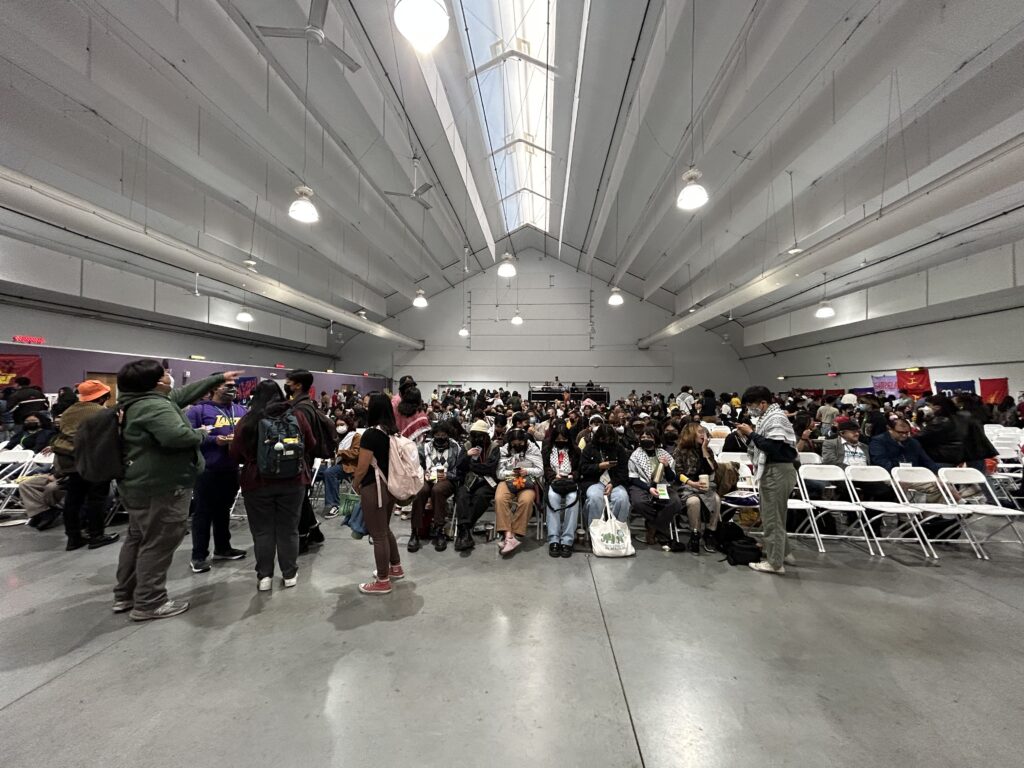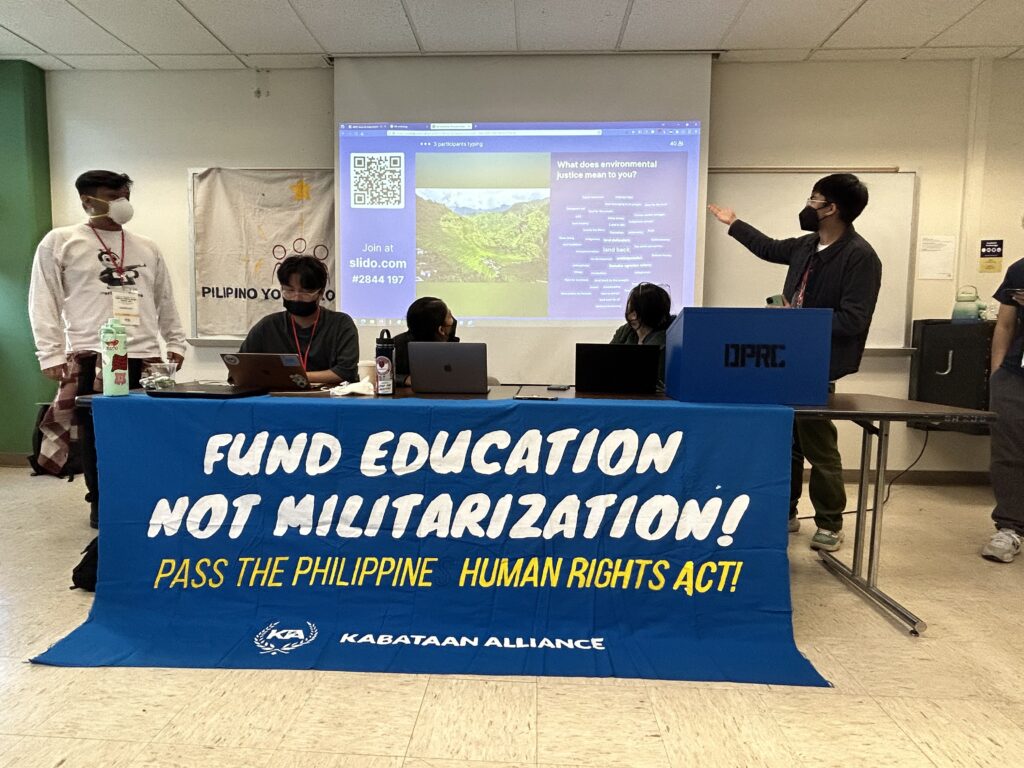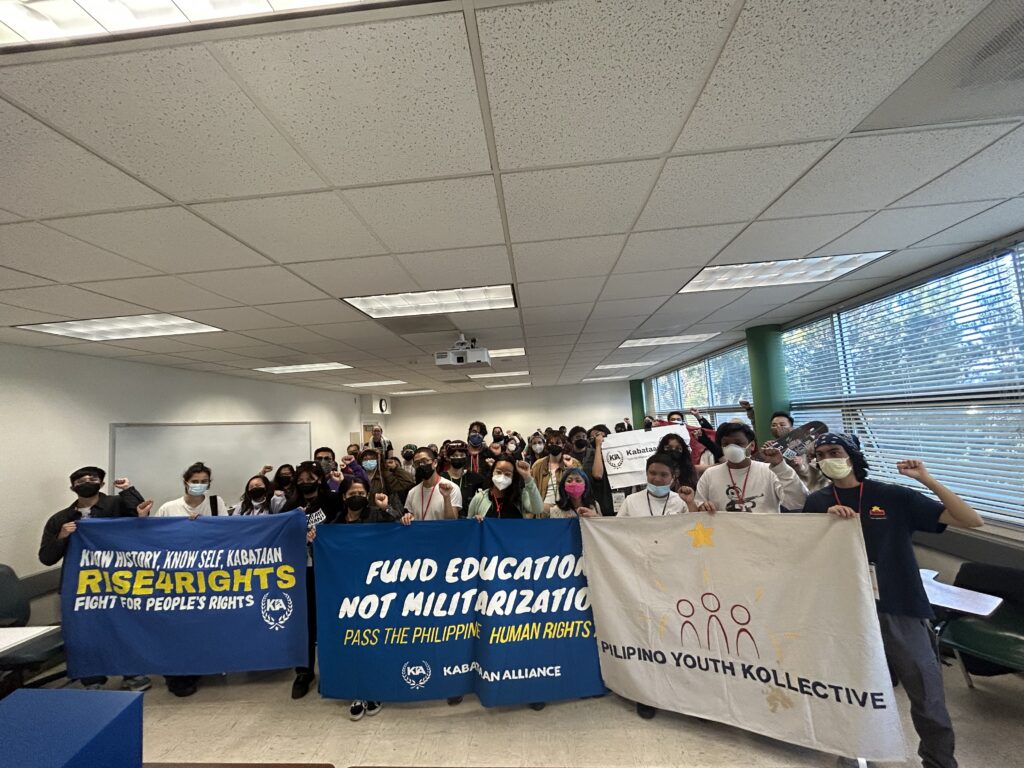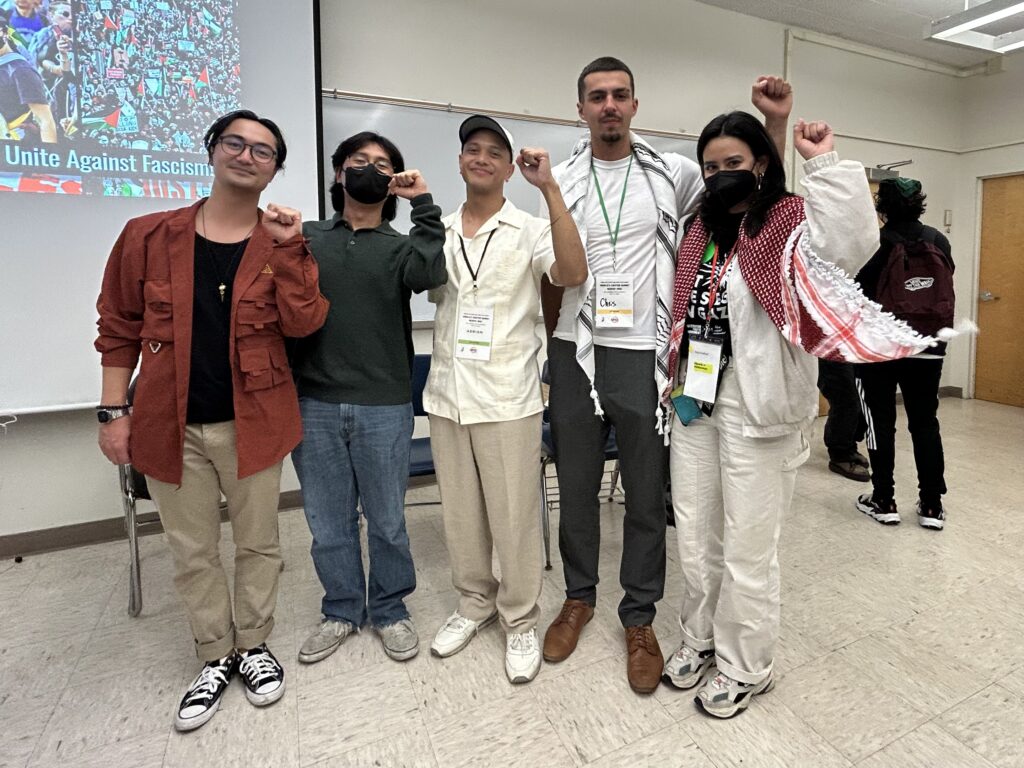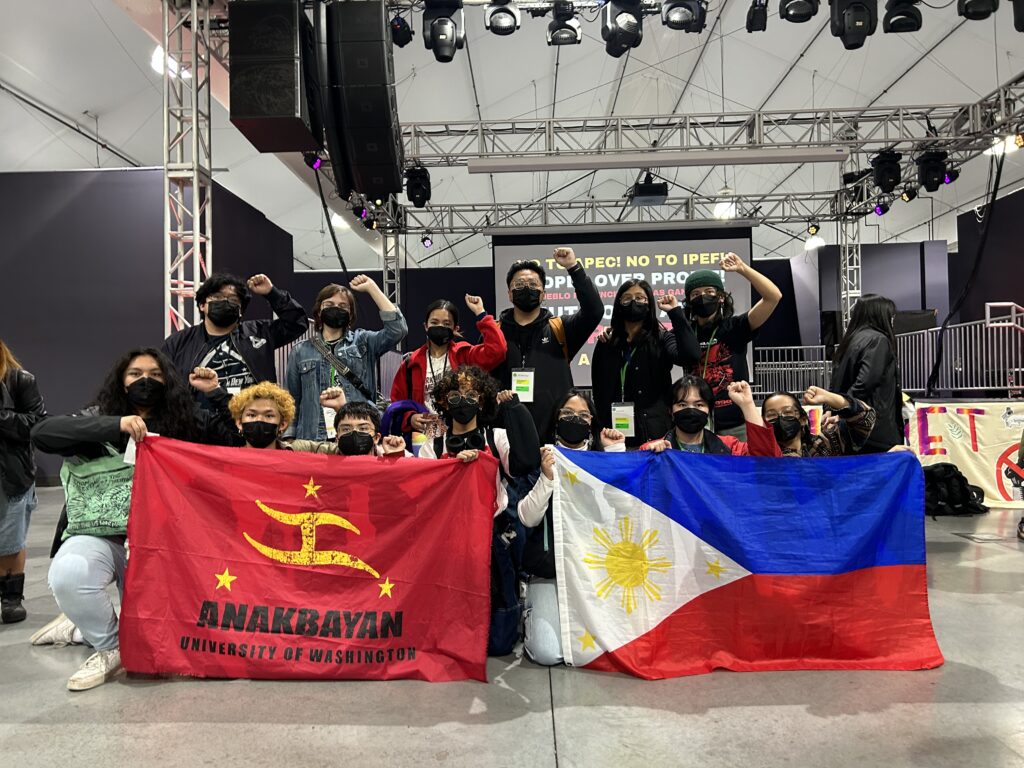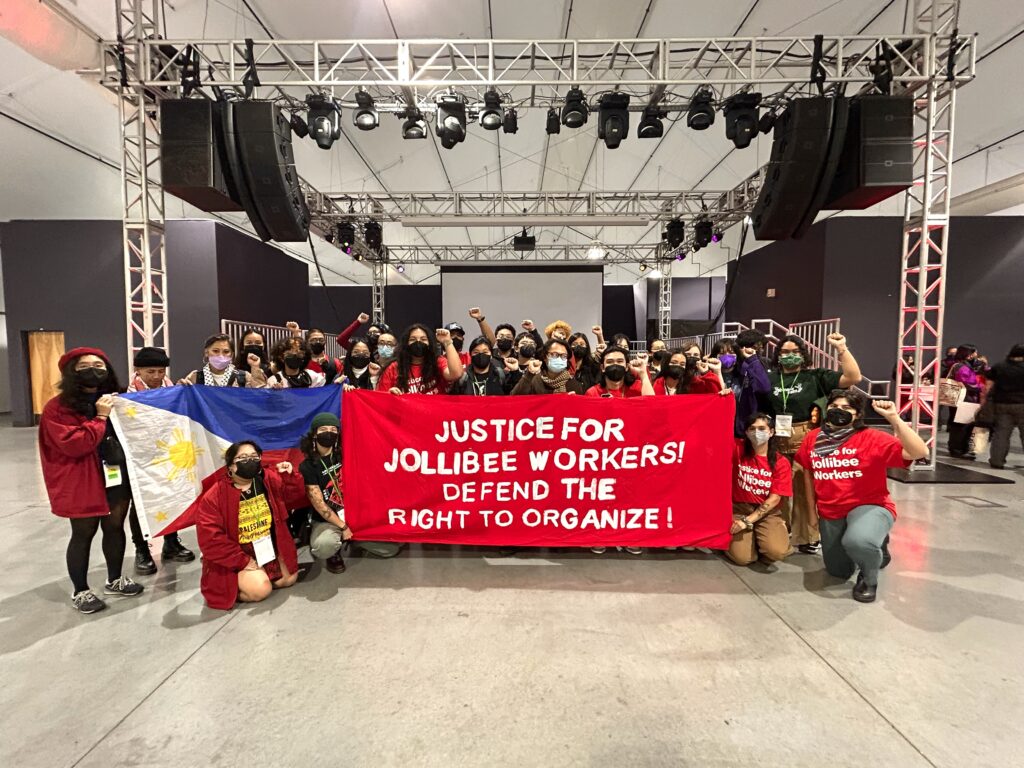By Jia H. Jung, California Local News Fellow
Anti-Marcos protestors shouted in English and Tagalog at Philippine president Ferdinand Marcos Jr. last week while armed police and barricades held them back from the shiny South San Francisco Conference Center. Inside, Marcos Jr. and his supporters dined at a welcome reception televised by Philippine media outlets.
The crowd’s vitriol exemplified decades-long concerns among global Filipino communities over the future of their former homeland and the impact upon themselves and their loved ones scattered around the world for economic opportunity.
Broader protests surrounded the Asia-Pacific Economic Cooperation (APEC) Economic Leaders’ Week from Nov. 11-17 in San Francisco that brought Marcos Jr. to town. Filipinos, incensed by Marcos Jr.’s presence in the Bay Area for the event, were a cohesive factor in the civil unrest.
Immigrants, overseas foreign workers (OFWs), and American residents and citizens spanning multiple generations convened from across the U.S. and beyond to maximize the APEC spotlight.
They arrived fully expecting APEC 2023 to benefit corporate interests by exploiting and abusing working Filipinos in the guise of the event’s theme of “Creating a Resilient and Sustainable Future for All.”
Their lives had been defined by the U.S.-Philippines relationship, and what they experienced as economic and environmental consequences of world leaders’ dealings at exclusive forums like the Indo-Pacific Economic Framework (IPEF) trade negotiations and APEC meetings of last week.
Filipinos are part of a century-old pipeline of service laborers, health workers, caregivers, and lately, teachers, to America.
The Statistics Bureau of the Philippines counted nearly 2 million Filipinos worldwide as registered OFWs in 2023. Their earnings now float 9% of the Philippine economy.
At the most conservative estimate and not counting undocumented people, 5,000 people a day leave the Philippines to find work, often separating from their families to do so.
Plenty of journalism has exposed how Filipino OFWs and seafarers around the world experience visa issues, wage theft, overwork, trafficking, and other abuses. In the U.S., the list of challenges includes Asian hate crimes.
Patrick Roque, 25, delivered a speech to fellow protesters on the night of Marcos Jr.’s arrival to San Francisco on Tuesday, Nov. 14.
Roque grew up in Muntinlupa, a city in Manila. His mother sold apparel and his father worked as a marketing manager for Coca-Cola but still could not get by. They moved to the U.S. without their children in 2008 to become a caregiver and operations manager at a fleet repair company, respectively.
Both parents worked 14 hours a day for six days a week. Grandparents and extended family looked after the children back in the Philippines.
Roque and his younger sister joined their parents in the U.S. in May 2017 after being without them for a decade.
In May 2022, Roque’s parents and youngest sister were at a McDonald’s drive-thru in North Hollywood. A man named Nicholas Weber rear-ended their vehicle while driving under the influence of alcohol and began spewing racial slurs and threats to kill the family.
Then, as captured on video footage published by KTLA 5, Weber also exited his vehicle to strangle Roque’s mother and shove Roque’s father to the ground, breaking one of the man’s ribs.
The Roques pursued a case against Weber, losing $12,000 in wages to appear in court instead of their jobs. The effort to obtain assistance and justice from the U.S. and Philippine governments was so traumatizing that the family settled for $600 from the Assistance to Nationals Fund of the Philippine Consulate.
Law enforcement dropped the enhancement of a hate crime from Weber’s charges.
Weber agreed to plea no contest to a pair of felony assault counts and one count of driving under the influence. He was sentenced to two years in Los Angeles County Jail and an order to participate in anti-bias and alcohol treatment programs. He was released on probation after a year and a half.
Roque intensified his pre-existing activities with Migrante Los Angeles, a migrant worker organization descended from BAYAN USA, the largest chapter of Bayan-Philippines grassroots alliance for democracy and sovereignty founded in San Francisco in 2005, now with sectoral organizations such as GABRIELA USA for women’s advocacy and Anakbayan USA for militant youth in addition to Migrante.
Roque traveled to San Francisco for APEC week to raise awareness of the Philippine economic crisis and state neglect at the root of his family’s sufferings.
In his speech, he also mentioned the physically attacked Arriola and Ochengco couple of Sacramento and the thousands of Filipinos who lost their lives and livelihood in the wildfires in Lahaina, Maui in August. The city was 40% Filipino prior to the fires, according to the Hawaii Department of Business, Economic Development and Tourism.
The victims have received little help even after paying fees to understaffed, inadequately funded social service arms of the Philippine government.
Yet, the Philippines allocates confidential and intelligence (CIF) funds to militarization and policing. Last month, Philippine legislators complained that Philippine Vice President Sara Duterte was misusing these funds; she responded by calling them terrorists.
Roque alleged that this power extended to the U.S. Last August, as Weber was being sentenced, members of the Philippine National Police showed up with false identities to Migrante’s community meeting with the Philippine Consulate General in Los Angeles. When caught, the agents claimed to be collaborating with the LAPD to better protect Filipino Americans.
The group believed it was being surveilled.
The broader No to APEC Coalition was overwhelmingly led and populated by Filipino participants, who found synergy with South Asian, Pasifika, Latino, Northeast Asian, and Palestinian communities, and global cause-based groups like the International League of People’s Struggle.
The assembly of over a hundred local, national and international community, human rights, justice, and labor organizations coordinated the march of thousands of protestors down Market Street in downtown San Francisco as APEC week began last Sunday, Nov. 11.
The precursor to this was a People’s Counter Summit entitled “People and Planet over Profit and Plunder” on Nov. 10. The all-day program of educational and community-building presentations and workshops took place at San Francisco State University, the institution that pioneered ethnic studies in 1969.
Chinese American Brandon Lee gave the keynote speech (read the transcription here). Lee became vehemently anti-APEC after aligning with global Filipino causes. Born and raised in the Bay Area, he moved to the Philippines and married an Indigenous Ifugao woman with whom he had a daughter. He was working as a humanitarian, land defender, and journalist in the mountainous Cordillera region north of Manila when Philippine armed forces shot him in front of his child on Aug. 6, 2019.
Lee named numerous people he personally knew who had already been killed by the state at this time. He narrowly escaped the same fate.
Now permanently paralyzed below the waist and unable to use his hands, he said, to the crowd of nearly 1,000 attendees in a gigantic university annex, “I am proud to be standing with you, metaphorically speaking, to fight back against APEC. Against state and political repression. Against the wealthy elite. Against the plunder of our planet. Against foreign domination of our peoples.”
The standing ovation and shouts of “justice for Brandon Lee” from the crowd suggested that Lee’s global perspective is resonating with more people in America as costs of living become unmanageable even with multiple jobs and shared housing.
This demographic is increasingly Filipino because of migration out of the Philippines due to climate change-related natural disasters, low wages, the highest inflation in Southeast Asia, lack of opportunity for economic advancement, and an atmosphere of political peril.
And they were waiting when Marcos Jr. touched down to the Bay.
Bongbong in the Bay
Philippine President Ferdinand “Bongbong” Marcos Jr. landed at SFO International Airport just after sunset on Nov. 14. to join APEC week with the 20 other heads of state at the largest gathering of world leaders in San Francisco since the signing of the U.N. charter in the city in 1945.
Marcos Jr. descended from the plane with First Lady Liza Araneta Marcos, who appeared in a shimmering baro’t saya style dress. He sported a barong tagalog.
The banana silk and pineapple leaf fiber garment was once assigned to Filipinos by Spanish colonizers. The clothing was sheer to deter concealed weapons and worn untucked to signal inferiority. The item eventually became the Philippine national dress, symbolizing anti-colonialism and resistance of the people.
The Filipino people on this side of the Pacific awaited Marcos at the South San Francisco Conference Center, his first stop before any APEC business or even his hotel. Guests of the presidential reception began filing into the venue around 2 p.m. – the pro-Marcos socialites, politicians, and select community leaders wore formal attire, national dress, and sequins.
The only explicitly named community group among them was the California Eagles, a social club that had organized a pro-Marco campaign during 2022 Philippine presidential elections.
The second group, about 300 strong, pressed up against metal barricades delineating a cop-patrolled no-go zone set approximately 150 feet from the gathering.
The event, broadcasted by Philippine media outlets, began with a nearly two-hour long entertainment program of pop music performances, audience karaoke, and contests to determine which of the attendees looked most like Korean actor Lee Minho or San Francisco Warriors basketball player Steph Curry.
Neil Frank Ferrer, Consul General of the Republic of the Philippines in San Francisco, made the opening address once Marcos Jr. was siphoned into the building from his caravan of black, tinted-window SUVs.
Ferrer toggled between Tagalog and English to announce distinguished guests from the Philippines. He then affirmed that the most votes for Marcos Jr. in the Americas had come from Philippine nationals living in the San Francisco Bay Area of California and across the 10 states of the Consulate General’s jurisdiction (Alaska, Northern California, Colorado, Idaho, Montana, Northern Nevada, Oregon, Utah, Washington State, and Wyoming).
Outside, protesters chanted and watched Philippine media’s livestreams of the ceremony from the parking lot.
BAYAN USA and all its sectors were there, along with the Kabataan Alliance of American youth serving Filipino communities in the U.S. and in the Philippines, Malaya Movement for Democracy established in 2017 in the wake of extrajudicial killings by former Philippine president Rodrigo Duterte, the Pilipino Association of Workers and Immigrants (PAWIS), and the International Coalition for Human Rights in the Philippines headquartered in Ottawa, Canada.
The Protesters, or Filipino Americans at the butt end of APEC
Kristal Osorio, 25, on the media team for the Community Response Actions of the Tri-City, California chapter of Malaya Movement, talked with AsAmNews before the protest.
A few years ago, while majoring in sociology and Race and Resistance at San Francisco State University, she became the political affairs coordinator with the Pilipinx American Collegiate Endeavor (PACE). In her junior year, she attended a conference hosted by Malaya Movement.
Everything she had been through in her life suddenly made sense.
When Osorio was in grade school back in Quezon City in the Philippines, she felt shame every time teachers announced in front of her fellow students that she had to go to the disciplinary office to sign a promissory note promising to pay tuition.
This is what happened whenever there was a wiring delay in allowances from her father, doing various contract jobs in the Middle East to put food on the table for his family and educate his kids back in the Philippines.
Osorio grew up never seeing her dad. She looked after herself and her little brother starting at age eight while her mother worked as an accountant. In 2011, when Osorio was 13, her mother fell ill, unable to work as medical expenses piled up.
The family of five reunited and migrated to the U.S via a petition by Osorio’s paternal grandfather, a veteran of World War II who had received American citizenship in exchange for his military service.
“I actually didn’t want to leave the Philippines,” Osorio said. “And it wasn’t really explained to me thoroughly. Like I only brought one jacket.”
In the U.S., the Osorios started off in a single-room rental that did not allow use of common areas, then moved to an apartment from which they got evicted before gaining steady housing in the Bay. Her parents worked at Nation’s fast food chain.
She kept asking her mother when they could go back home. “When we have money,” her mother replied.
The Osorios are still here.
Now 25 and out of college since her online mid-pandemic graduation in 2020, Osorio works two jobs to live independently from her parents with two housemates in Fremont, California. She is trying to decide whether the outlay of nearly $1,000 to apply for American citizenship is worth it. She could not afford the cost and time required by the process.
“My experience is not an isolated case,” she said. “My family’s story is not ‘it just happened because that’s just the way it is,’ but there’s actually a deeper root in history. And it’s because of these economic and social-political issues. There are actually people behind these systems that allowed my family to have to migrate. So that’s like one of the things we want to highlight today, like why are there so many Filipinos everywhere, right?”
In regard to Marcos Jr.’s arrival to San Francisco, she said, “The main objective of the action is to let the participants know what he’s coming for.”
What Marcos came to do at APEC
In an article in The Nation published shortly after Marcos Jr.’s arrival to the Bay, Brandon Lee, explained the Indo-Pacific Economic Framework for Prosperity (IPEF) being negotiated alongside APEC meetings as “the trade aspect of America’s desperate attempt to gain the upper hand in its competition with China.”
As evident in a statement by U.S. Treasury Secretary Janet L. Yellen prior to IPEF negotiations and APEC week, America’s priority is to maintain its edge over China without appearing to compete against the world’s number two economy.
This means that the U.S. seeks to build up its resources in and relationships with non-China countries in the Asia-Pacific countries and project more military power in the region. While financial and trade analysts focus on the implications of the U.S.-China powerplay, people from all the other countries wonder how they will be commandeered to serve the macrogeopolitical and economic game.
Protesters felt that Indigenous, poor, and working class Filipinos would be sold out by Marcos Jr. in exchange for money and military support.
The Philippines has a third of the population of the U.S. spread across valuable, resource-rich, and energy-filled 7,641 islands. Meanwhile, the country has but 1% of America’s GDP, making it literally the other 99% in trade deals billed as free and fair.
The Philippines is not comparatively poor because it has little to offer other than cheap unskilled labor, but protestors say it has been exploited for its riches for centuries, starting with colonization by Spain in 1565 and continuing with colonization by the U.S. from 1898 to 1946.
These conditions have entrenched mass poverty and the violation of human rights of people on land and water sources that have not been deforested, mined, dammed, or overfished by foreign interests.
The World Bank states that Indigenous people of the world now make up only 6% of Earth’s population but live on 80% of the planet’s remaining biodiversity. This describes parts of the Philippines, where peasants make up 75% of the current Philippine population.
Among these peasants are Indigenous people who live on not only the islands’ but the world’s last frontiers of mineral reserves desirable for mining (enabled by the APEC-endorsed Philippine Mining Act of 1995 to allow foreign companies to mine in the country), native forests coveted for furniture or land clearance for slash-and-burn farming, nutrient-rich soil for mega plantations of companies like Dole and Monsanto, renewable energy sources for more developed countries seeking to go green, beautiful scenery ripe for tourism, and marine biodiversity conducive to overfishing.
All this is in the middle of a historically and geographically critical military hub for a region constituting two-thirds of the world economy, according to the latest Indo-Pacific Strategy shared by the White House.
Finally, there are people suppressed by the state – people who end up providing cheap labor in the Philippines and overseas to sustain themselves and stay alive.
Human rights violations in the Philippines perhaps entered mainstream American consciousness during previous Philippine president Rodrigo Duterte’s deadly so-called war on drugs. The Philippine government has admitted to approximately 6,200 killings on Duterte’s watch but the International Criminal Court is still investigating whether the toll was much higher as journalistic outlets, non-profit organizations, and opposition politicians have alleged.
Meanwhile, sources like the Human Rights Watch organization publicize killings of journalists in the country (most recently a shooting of a radio broadcaster Juan Jumalon in Culamba in the southern Philippines while he was on-air on Nov. 6). At the end of last year, Voice of America reported the Philippines as having had the most killings of journalists after Iraq, Syria, and Mexico. The National Union of Journalists of the Philippines documents and spreads awareness about the “red-tagging” of reporters. Red-tagging brands people as insurgent Communist enemies of the state, giving the government and armed forces license to kill them with impunity.
Indigenous people in remote subsistence communities continue being removed from their land for household name companies like Nestlé and are routinely killed for resisting. Workers and advocates demanding rights become red-tagged just like journalists speaking the truth. These are the people Brandon Lee both specifically named and exemplified at the People’s Counter Summit, and whom anti-Marcos protestors were championing.
In contrast to Duterte, Marcos Jr. appeared to be a star ally for the U.S. and a new hope for regional security when he took office in June 2022. But many believe Marcos Jr. should not even be in power. His father, military dictator Ferdinand Marcos, was overthrown by a people’s revolution in 1986 and fled to exile to Hawaiʻi in disgrace in American helicopters after pocketing billions of dollars of national funds that remain unaccounted for.
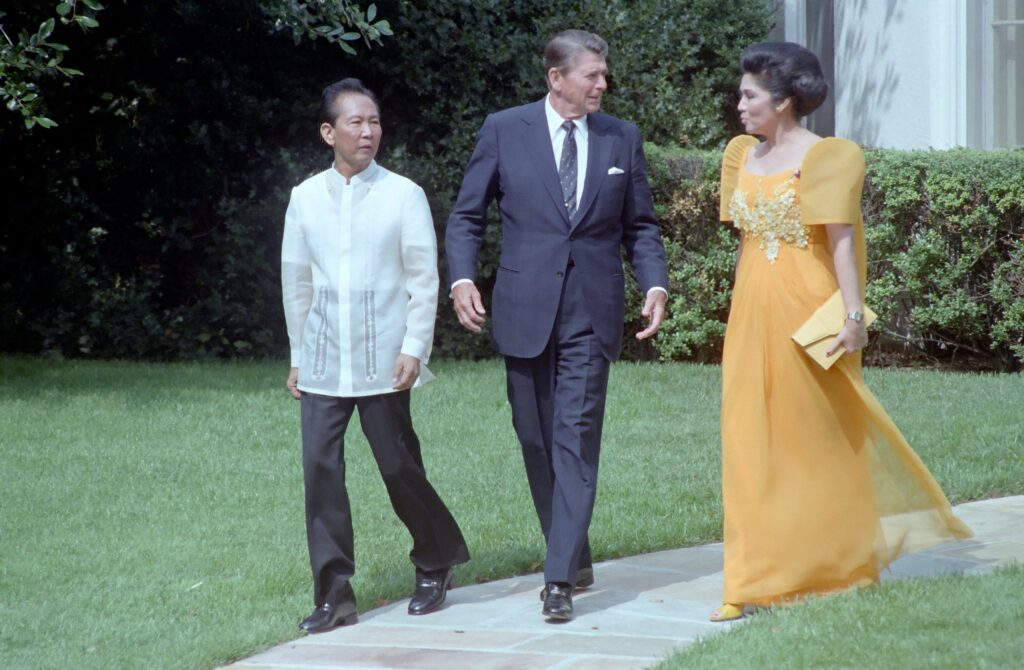
Decades later in 2022, Marcos Jr. won the Philippine presidential elections against Leni Robredo on a landslide lubricated by fake news, according to VERA Files, a watchdog based in the Philippines. The research contributing to this assessment has been cited by global journalism ethics and accuracy nonprofits such as the Poynter Institute and is widely accepted among intellectual and journalistic sources in the U.S. and abroad.
In South San Francisco last week, Marcos Jr. gleamed, “You delivered the Marcos-Duterte tandem while setting the highest voter turnout in absolute numbers in the entire Americas region.”
He said that he hoped to sign agreements with “various American businesses in the fields of digital infrastructure and connectivity, renewable energy, electronics manufacturing, health and tourism among others.”
Mirroring APEC, he asked for support in building “a resilient, sustainable, and inclusive future” that will “leave behind a new Philippines that our children and our grandchildren deserve.”
His address was followed by a performance by Florante (Boy De Leon) of Ako’y Isang Pinoy (I Am a Filipino), an ode to Filipino identity. The musician had initially been one of the first Filipino folk artists ever to sing out against Marcos Sr. for not “vacating his throne.” Eventually, he became a paid Marcos loyalist who was then a political target of the Aquino government after the 1986 revolution that unseated Marcos Sr.
Officials and Marcos Jr. himself mouthed the song’s lyrics from their seats.
The protestors, in hysterics, countertweeted the livestreamed event from outside.
What the people want vs. APEC outcomes
The anti-Marcos protesters who flocked to the Bay Area in a people’s movement concurrent with APEC week prepared a People’s Budget in the Philippines. The proposal has over 1,000 signatures on it with specific requests for how Marcos Jr. can put people over profit, now.
The document asks for public funding in the Philippines to go to diplomatic services, welfare, and citizen protections for Overseas Foreign Workers (OFWs).
The 2022 Survey on Overseas Filipinos conducted by the Philippine Statistics Authority revealed that a little over 6% of OFWs from the Philippines worked in the Americas. According to the Central Bank of the Philippines, these OFWs in the U.S. alone generated over 40% of all remittances.
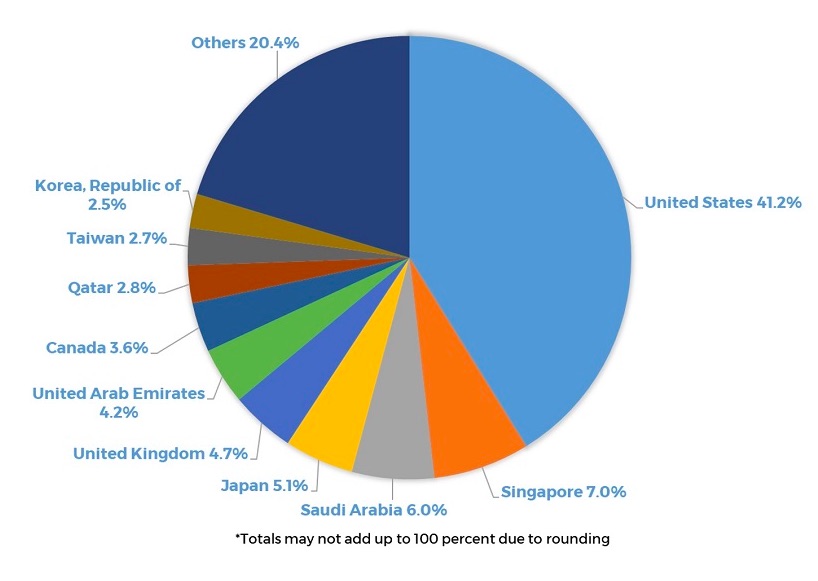
At his welcome reception, Marcos Jr. acknowledged the same, stating that OFWs in the U.S. were the single biggest source of cash remittances to his country, contributing $4.89 billion to the Philippine economy.
He also boasted that OFWs are the “kings and queens of overtime” and said that the disproportionately affected Filipino frontline health workers of the COVID-19 crisis showed Americans “the Filipino way of caring and acting in the needs of others.”
It was unclear to the protesters whether the needs of the people would be met at an event claiming to include everybody in its deliberations. After the events, Filipino American Adrian Bonifacio, national chair of BAYAN USA, shared an analysis of IPEF and APEC outcomes:
“There may be short-term gains that on the surface seem beneficial (high dollar figures for foreign investments, minimal job creation), but the economic development strategy that Marcos and APEC have been pushing that centers on foreign investment without having a stable base of Philippine industry has historically not worked and has even left the country and people worse off in many ways.”
The IBON Foundation’s position paper released earlier recommended updates to the 1987 Constitution of the Philippines after analyzing the effects of the same economic approach Marcos Jr. announced at APEC. The non-profit research and education institution also tracks and provides data on how poverty and unemployment have steadily worsened for Filipinos despite increasing foreign investments.
The APEC Ministerial Meeting hosted by U.S. Secretary of State Antony Blinken and U.S. Trade Representative Katherine Tai on Nov. 14 and 15 made commitments to increase the participation of people with “untapped economic potential,” like Indigenous communities, disabled people, women, and “people from remote and rural areas” in modern industries. The ministers also agreed on strengthening science, technology, engineering, and mathematics (STEM) education and vocational training for the “reskilling and upskilling” of these people.
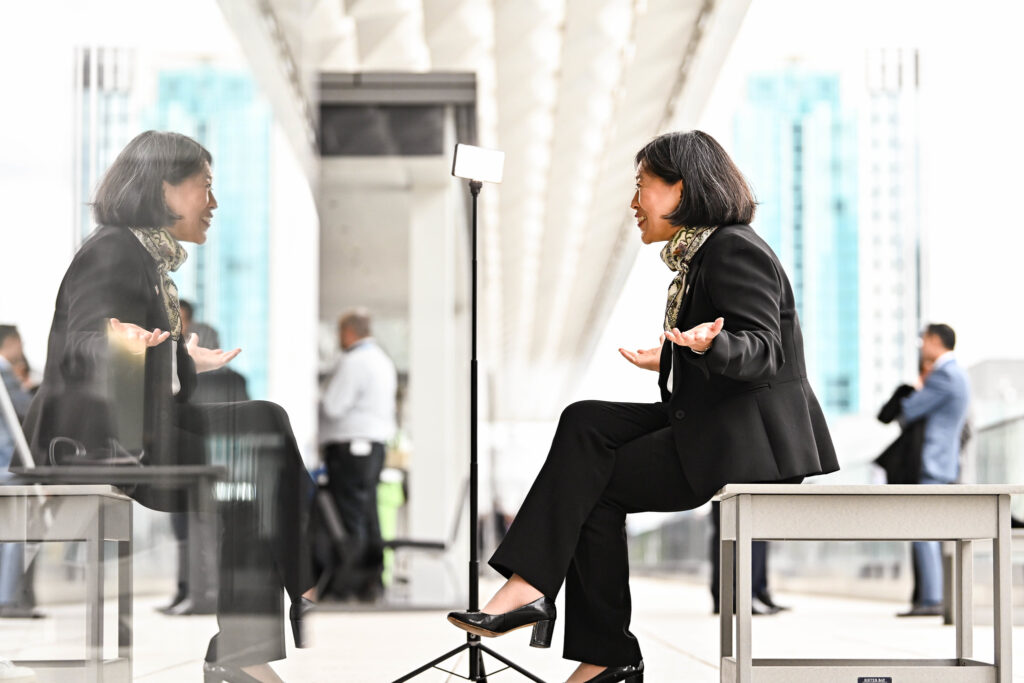
The APEC CEO Summit followed on Nov. 15, led by Amazon, FedEx, Citi, Mastercard, Visa, Google, Meta, Microsoft, Boeing, Uber, Johnson & Johnson, and Pfizer, among other companies.
Marcos Jr. spoke on a panel called “Intentional Equity in Sustainability” at the gathering. Referencing everyday Filipinos, he said, “They do not only provide the most important voice in terms of the bare minimum that we should be according to [sic], but also knowledge, skills, and talents so far untapped or underutilized in our efforts, especially towards the circular economy, environmental preservation and protection, utilizing Indigenous sources and nature-based solutions, and adopting sustainable practices.”
He added, “cognizant that our priorities, our strategies, and approaches differ, platforms such as the APEC [sic] prove instrumental in finding policy congruences and coordination of our efforts.”
He then shared five points for how such coordination should take place. The language was promising but clearly prioritized government intervention and the overlooking of noncompliance with environmental standards in order to accelerate growth in green and digital sectors in accordance with the five-year Philippine Development Plan ending in 2028.
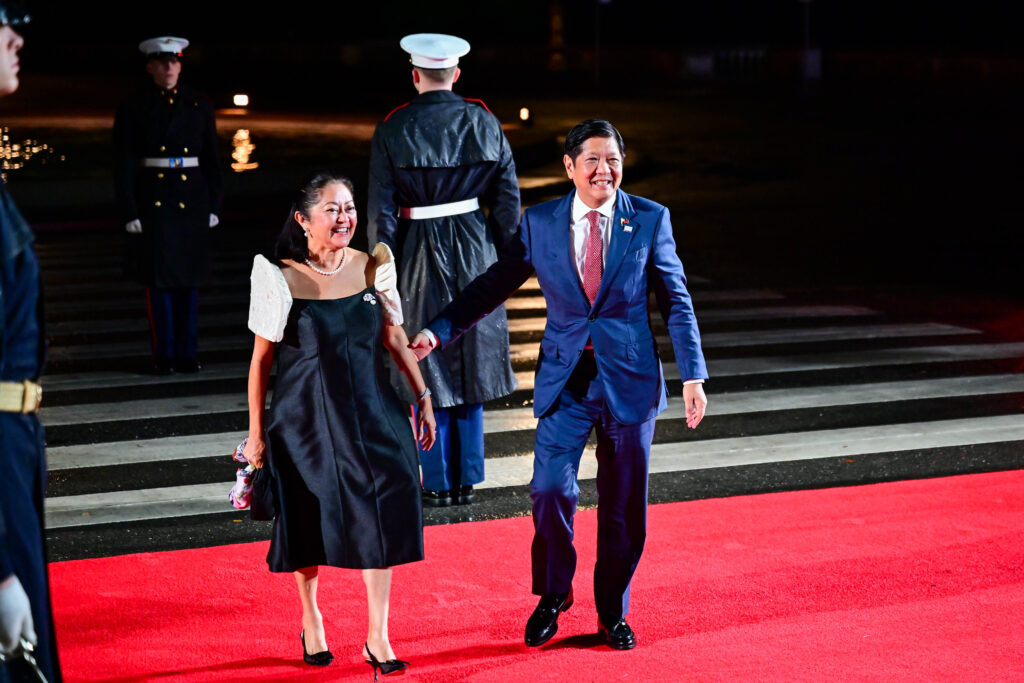
The next day, at the IPEF leaders’ announcement, President Biden reiterated three of the trade framework’s known principles: supply chain security, clean energy transition, and reduction of corruption in trade. The U.S. did not actually come out of APEC with a complete IPEF agreement.
When it came to labor and environmental standards, Biden said that the negotiators had “made progress” on the matters while deciding to launch a critical minerals dialogue to further strengthen American supply chains and install more clean energy ventures abroad.
The president also unveiled the U.S.’s new “Investment Accelerator” to fast-track private investment for new enterprises in foreign lands.
“You’ve heard every one of my colleagues say one time or another that this can’t be done without trillions of dollars of private sector investment — to get hold of this and get ahold of it quickly to give them confidence to make those investments,” he said.
“Government investment is not enough,” he added.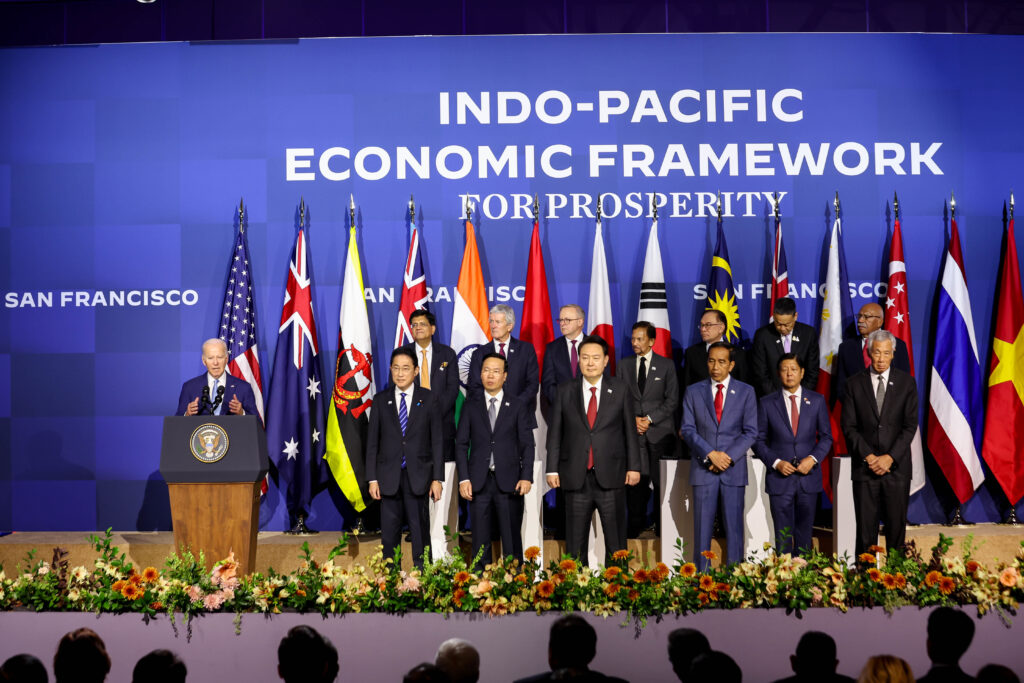
Just one business manifestation of the separate but compatible statements by Marcos Jr. and Biden is that Manila Electric Co. (Meralco) and the Seattle-headquartered Ultra Safe Nuclear agreed to move forward in installing small modular nuclear reactors in the Philippines.
Community organizer Tabitha Ponciano of Malaya Movement had worried that this type of deal would happen between the Philippine energy company and NuScale Power small modular reactor corporation in her resident state of Oregon. She said that the technologies were not adequately tested and balked at the thought of nuclear plants being placed in an earthquake and storm-prone country.
Militarization upstages economic conversations
In a private conversation “on the margins of” APEC between Marcos Jr. and Vice President Kamala Harris, the two economies finalized the “123” Civil Nuclear Cooperation Agreement between the U.S. and the Philippines. According to the White House, “This agreement will provide the legal basis for U.S. exports of nuclear equipment and material to the Philippines, which will support American workers and businesses.”
Harris and Marcos Jr. also renewed their vows to a version of the Mutual Defense Treaty first authored after World War II in 1951.
This means that an armed attack by China in Philippine exclusive economic zones (an area extending 200 miles from every country’s shores) in the West Philippine Sea will, in the words of the White House “invoke U.S. mutual defense commitments.”

While this may comfort many Filipinos and fishers worried about real and mounting clashes with China over marine resources and territory, ramped-up militarization also means physical and material re-installation of American power in the Philippines after formally withdrawing in 1992.
In April, the U.S. defense department announced plans for four new Enhanced Defense Cooperation Arrangement (EDCA) sites in the Philippines. On Nov. 9, right before APEC, the U.S. carried out conspicuous coastal military defense drills off coast the Philippines with South Korean and Japanese forces in a flex against China. Such activities not only raise worries about the possibility of World War III, but also the potential for more military and police force to be exerted upon disadvantaged Filipinos as has happened in the past.
Aversion to militarization underlies Filipino international solidarity with Palestinian communities and the calls for a ceasefire in Gaza. And, of course, there are overseas Filipinos actually caught in the conflict zone.
Thirty thousand Filipinos (along with an equal number of Thai people) live in Israel, mainly working as caregivers. Since the outbreak of the Israel-Hamas war, some have been killed by Hamas and unknown circumstances.
At least 134 known Filipinos were living in Gaza when the Oct. 7 attack by Hamas took place, many in families with Palestinians. Some have fled the American-backed retaliation against Hamas, leaving loved ones behind. Others are staying, pleading to include their Palestinian family members in their escape.
Bongbong flies away
On Thursday, Nov. 16, Marcos Jr. and Liza Marcos enjoyed red carpet treatment at the palatial Legion of Honor for the APEC Leader and Spouse dinner. When they returned to The Ritz-Carlton for their last night in San Francisco, the anti-APEC, anti-Marcos contingents and their allies were waiting.
They chanted, “Marcos, you’re not welcome here! The Philippines is not for sale!”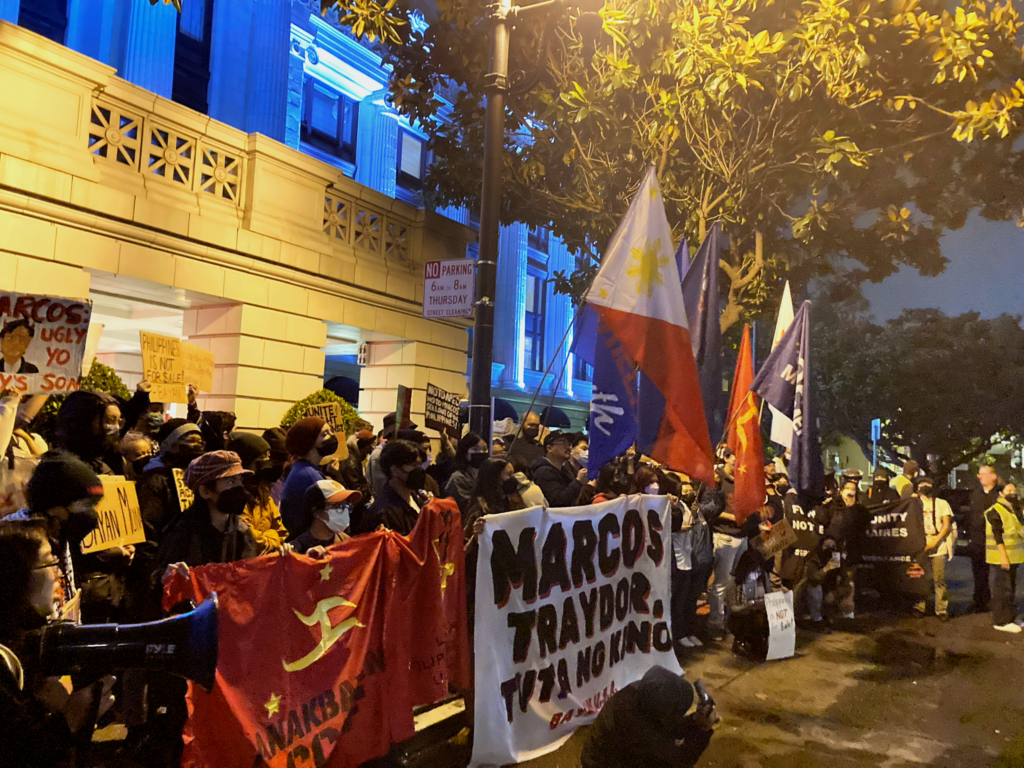
The vehicle containing the Marcoses sped into the parking garage, leaving behind a car of employees to run uphill, exposed, to the main entrance of the hotel.
“If Marcos can so readily abandon on the street even the staff that work for him, what more for the everyday Filipino person?,” asked Bonifacio, in a press release by the Malaya Movement.
That same night, the 21 heads of state had put together a Golden Gate Declaration with 16 resolutions to take a “market-driven” approach to create a “level playing field” for trade and investment, all while tripling global renewable energy capacities and guaranteeing global food security within the next five years.
(All official outcomes documents can be viewed here.)
As for Marcos, he flew off to Los Angeles the next day and then Hawai’i for the weekend to see his supporters at the Hawai’i Convention Center and become the first Philippine president to cast a shadow at the US Indo-Pacific Command headquarters. Anti-Marcos Filipinos were waiting in both locations.
In Honolulu, protestors held high a Marcos Jr. effigy painted by the people and screamed “No aloha.”
Marcos Jr. is seeking $23 million in funding from his government for overseas business travel in 2024, with the reasoning that he will raise funds to make up for the expenditure.
AsAmNews is published by the non-profit, Asian American Media Inc.
We are supported through donations and such charitable organizations as the Robert Wood Johnson Foundation. Donations to Asian American Media Inc and AsAmNews are tax-deductible.
Please also follow us on Instagram, TikTok, Facebook, YouTube and X.

